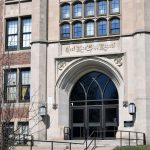Then, now and in the future

Hardened by work, this iconic image of labor in bronze is at MSOE’s Grohmann Museum. Photos by Brian Jacobson
Happy Labor Day! Enjoying your extended weekend, barbequing, golfing and soaking up the sunshine now that we’re at the official end of summer? It’s seems sort of trite to say “Thank a union member” for this holiday, considering what has occurred in Wisconsin over the last eight months. But the work world that we enjoy as employees was fought for and won by laborers.
When I think of laborers I think of those depicted in the bronze statutes in the rooftop garden of the Grohmann Museum at the Milwaukee School of Engineering. Factory workers, coal miners, butchers – toned, sweat-drenched, and made tough by a hard day’s work. The electricians, carpenters, masons and drop forge workers who came into my father’s third-shift tavern in West Allis; those are who I think of when I think of Labor Day.
Yesterday’s workers unionized to fight for safe working conditions, shorter work days and weeks, health care and pensions. Today, thanks to those early efforts, work weeks, minimum wages and work safety for everyone in the American workforce are now regulated by a variety of state and federal agencies.
Timeline of the Labor Movement
The modern labor movement got its start during the Industrial Revolution of the 1880s. Private factories, mills and shops were operated by owners who took advantage of workers. Crowded conditions and overworked employees led to injuries and fatalities. Dangerous jobs in steel and coal led to illnesses and early deaths. Children went to work instead of school, leading to a permanent underclass controlled by corporate interests.
There were no consequences for the owners. If a worker quit, was injured or died, there were plenty more able bodies available off the immigrant boats from Europe. Money was being made and workers were expendable.
Tired of dangerous work conditions, 12-hour work days and a seven-day work week, employees began to organize among themselves in protest. The first Labor Day was held in 1882, organized by the Central Labor Union of New York. It included many of the same events we see today – a parade, speeches and a picnic to honor workers – and drew over 10,000 participants.
Organizers continued to hold rallies and marches. Some turned violent, like the Haymarket Riot of 1886 in Chicago, which began as a rally to support workers’ rights and ended with eight police officers and an unknown number of civilians dead.
But the movement spread, with the Pullman Strike bringing the battle between management and labor into the public’s view. On May 11, 1894, employees of the Pullman Palace Car Company in Chicago went on strike to protest wage cuts and the firing of union representatives. On June 26, the American Railroad Union, led by Eugene V. Debs, called for a boycott of all Pullman railway cars, crippling railroad traffic nationwide. To break the strike, the federal government dispatched troops to Chicago under the guise that the work stoppage was harming the delivery of mail. The move started a wave of riots that resulted in the deaths of more than a dozen workers.
In the wake of unrest, Congress passed an act making Labor Day a legal holiday in the District of Columbia and the territories.
But having a day off to parade and celebrate did not quell the labor movement. Activists continued to lobby for eight-hour days, 5-day work weeks and the end of child labor. Slowly, various unions obtained these rights, but the national eight-hour day and the end of child labor wasn’t realized until 1937 with the passage of the Fair Labor Standards Act.
The FLSA set a national minimum wage, guaranteed “time-and-a -half” overtime in certain jobs, and prohibited the employment of minors in hazardous work conditions. It has been amended numerous times to increase the minimum wage and add protections to minorities, women, older workers and the disabled. However, it applied only to private employers until the early 1960s.
In 1961, the protections were opened to school teachers, medical workers and nursing home attendants. In 1966, farm workers were included under the FLSA standards. By 1983, migrant and seasonal workers were given protections, and in 1985 the act was expanded to allow compensatory time in place of overtime for public workers.
During that same time period, union membership grew from 7 percent of American employees in 1930 to its highest level of 35 percent of workers in 1945. This year, union membership has fallen to 11.7 percent of the employed.
At the same time, the face of union membership has changed, moving away from private employer unions to the predominance of public employee unions. While early union membership was heavy in industry, in 2011, only 6.9 percent of private sector employees belong to a union, while over 36 percent of public employees do. Much of that shift is a result of the erosion of manufacturing jobs in the auto and steel industries, long the stronghold of American private sector union jobs.
Most union members today work in education, training, library services or protective services (such as police and fire). But their motivation for organizing is not to gain fair wages or shorter hours; much of that is protected by the FLSA and civil service laws. Now, unions battle for a more equitable distribution of wages, sick and paternity leaves, portable health insurance and the right to bargain.
Present-day challenges
Wisconsin has recently been the epicenter of many of those battles, as Gov. Scott Walker restricted the bargaining rights of public workers to only wage discussions. Last February and March, public workers from around the country came out in droves to support the right to bargain in an unsuccessful fight against major policy changes in Wisconsin. Now, some workers must beg to just be part of the process on their working conditions.
Over the past two weeks, public school teachers have protested during school board meetings in New Berlin, Burlington and Greenfield, as districts freed from union contracts have set up new requirements for teachers without collaboration or even consultation. While some of the changes seem minor – requiring knee length skirts and no jeans for teachers – others extending work hours or rescinding pay for extracurricular programming have sparked outrage from teachers and staff.
Opponents of public unions have made it more difficult by eliminating the automatic collection of union dues from paychecks and requiring annual re-certification votes. Both these moves have already started a reduction in union membership in Wisconsin, with the University of Wisconsin Teaching Assistants choosing not to certify this year and the Wisconsin Education Association Council cutting their own staff in light of monetary losses.
Columnist and political organizer Robert Creamer stated that without unions and the right to bargain, the middle class will disappear and more and more wealth will be concentrated in the upper class.
“Collective bargaining is the only way to level the playing field — to assure that increases in American productivity are widely shared throughout the economy,” Creamer writes on the Huffington Post.
According to Creamer, American workers and our economy need unions now more than ever. He describes them as the “only means by which we can guarantee widely-shared economic growth.”
No matter your personal opinion on unions, we can agree that their impact on our nation has been profound. We all benefit from the 40-hour week and other work rights that were fought for and finally settled into law by the unions. While I am a free-market advocate, I believe there is nothing wrong with checks and balances on management and providing a method for employees and employers to sit down and discuss the workplace.
On this Labor Day, hopefully the rhetoricians can move beyond the tumult of the past several months and seek a way to come back to some middle ground — for the sake of the workers who fought before us.






















